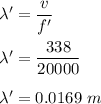
Physics, 15.04.2020 03:27, isabelj2004
The range of human hearing extends from approximately 20 Hz to 20 000 Hz. Find the wavelengths of these extremes when the speed of sound in air is equal to 338 m/s. The smallest wavelength that can be heard is: Incorrect: Your answer is incorrect. m The longest wavelength that can be heard is: m

Answers: 1
Other questions on the subject: Physics


Physics, 22.06.2019 10:00, andresduenas72
Aria drove to the store, did some shopping, and then came home. during maria's trip, when was her displacement equal to zero?
Answers: 1

Physics, 22.06.2019 13:10, alejandramirand9836
A0.750 kg aluminum pan is removed from the stove and plunged into a sink filled with 10.0 kg of water at 293 k. the water temperature quickly rises to 297 k. what was the initial temperature of the aluminum pan? the specific heat of aluminum is ca = 900 j/(kgk) and water is cw = 4190 j/(kgk)
Answers: 3

Physics, 22.06.2019 17:10, lesok0818
Which statement best describes the superposition principle? a.) if two in-phase waves arrive simultaneously at a point, their amplitudes add up b.) if two out-of-phase waves arrive simultaneously at a point, their amplitudes add up c.) if two in-phase waves arrive at a point one after another, their amplitudes add up d.) if two out-of-phase waves arrive at a point one after another, their amplitudes adds up
Answers: 2
Do you know the correct answer?
The range of human hearing extends from approximately 20 Hz to 20 000 Hz. Find the wavelengths of th...
Questions in other subjects:


Health, 06.10.2019 17:30




Health, 06.10.2019 17:30



History, 06.10.2019 17:30

Chemistry, 06.10.2019 17:30



 is wavelength of wave
is wavelength of wave





